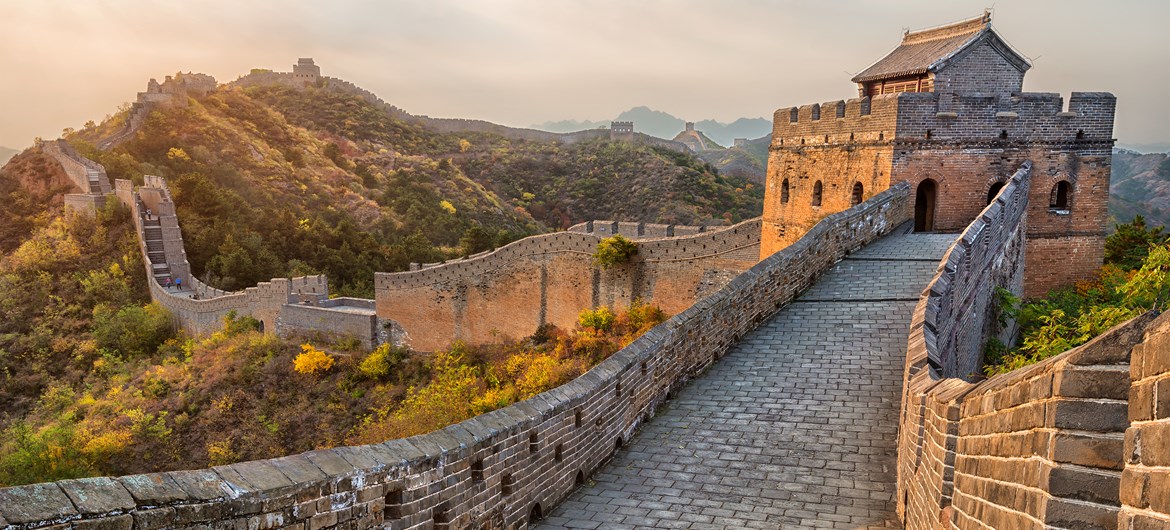Three years ago, I visited Beijing and by far the best thing I did there was visit the Great Wall of China. The scale of the Wall and the amount of time it has lasted, as well as the huge number of visitors it attracts every year are all reasons that I decided this should be the next place in my Ancient Wonders series.
Contrary to popular belief, the Great Wall was not built all in one go, and was not built solely to repel invaders. The earliest parts of the wall were started around the seventh century BC by individual states, including Qin, Wei, Zhao, Qi, Yan, and Zhongshan, to defend their own borders against other states. The individual parts didn’t quite all join together, but covered a fair amount of land. The initial walls were made out of compacted earth and gravel.

The sections of walls built by individual states c. 7th century BC. From China Highlights.
In 221 BC, King Zheng of Qin unified China after extensive conquering and became the first Emperor of the Qin dynasty. Qin destroyed the previous sections of the wall that divided one territory from another in an attempt to unify the country and decrease the defensive power of local lords. However, in order to protect his new, fragile empire from attacks from the north, he built new walls to connect the remaining sections of wall together into one large fortification. Compacted earth was again used, with stones from the nearby mountains also reinforcing it. Most of these Qin walls have eroded over the past 2000 years, but a few small sections still remain. This wall building was a monumental task. It is estimated by some historians that anywhere up to a million people died building the Qin wall.

The Great Wall under Qin’s extensions. From China Highlights.
Later dynasties extended or rebuilt sections of wall, but the Qin wall laid the foundations. The next big phase in the Wall’s history was in the fourteenth century under the Ming dynasty. The Ming army had been defeated by the Oirats, a western group of Mongols, in the Battle of Tumu. This came as part of a series of extended conflicts and successive battles that was weakening the Chinese empire because they were not able to successfully repel the Mongols for good. It was decided that the walls should be extended across the Northern border of China in order to stop the tribes of Mongolia from entering the empire, thus protecting the Chinese from further prolonged fighting.
The Ming wall followed the bend of the Yellow River, leaving the Mongol tribes alone in their control of the Ordos Desert. This is where the wall moved away from using compacted earth, and bricks and stones were used instead. Thousands of watchtowers – up to 25,000 – were built along the length of the wall to increase defensive power. The strongest parts of the wall were always the sections closest to the capital, Beijing.

Watchtowers such as this were built all across the wall. They would light beacons in case of invading forces.
Nonetheless, raids from Mongolia continued throughout the Ming dynasty, and successive rulers continued to reinforce and repair the wall. One particularly busy period was the 3 years between 1567 and 1570 under Emperor Qi Jiguang who added another 1,200 watchtowers in order to better warn of approaching raids.
The huge investment Chinese emperors made to the wall paid off in the early seventeenth century when Manchu invasions began. The Chinese lost the province of Liaoning to the Manchus, but the Ming army was able to prevent the invaders from conquering the rest of China because of the heavily fortified section of wall known as the Shanhai Pass. The Manchus did eventually cross the wall in 1644, but this was only after Beijing fell to rebels. The commanding general of the Ming army, Wy Sangui, had opened the gates at Shanhai Pass for the invaders in the hope that the Manchus would expel the rebels from Beijing. The Manchus did successfully stop the rebels, and they began their own period as rulers of China as the Qing dynasty. Once the Manchus formed the Qing dynasty, further extensions to the Great Wall ceased as Mongolia became part of the Chinese Empire and the Wall was no longer needed for defence.

Shanhai Pass, meaning “First Pass Under Heaven” in Chinese. Its name is written in Chinese above the gates.
The Great Wall of China was not used solely for defence, however. Across the centuries, the wall was vital to maintaining the Silk Road trade route that connected Asia to Europe. As early as 130 BC, westward wall-building was vital to encouraging trading along the Silk Road, as it made travel safer for merchants. Not only did the wall protect merchants and encourage international trade, but it allowed trade regulation to occur. This meant the government could keep an eye on what trading was happening, and extract the necessary taxes and duties – the money of which most likely went straight back into maintaining the walls. The walls also allowed important control of migration.
The Great Wall of China in its current state measures 21,196 km (13,171 miles), with the Ming section measuring 8,850 km (5,500 miles). Even in recent history, new stretches of remote or hidden sections of wall have been found. In 2009, 180 km of previously unknown sections of the wall concealed by hills, trenches and rivers were discovered using infrared range finders and GPS devices. In 2015, a further 9 sections with a total length of over 10 km were discovered. Due to erosion, vandalism, and construction, huge sections of the Great Wall have been lost:
“A 2012 report by the State Administration of Cultural Heritage states that 22% of the Ming Great Wall has disappeared, while 1,961 km (1,219 mi) of wall have vanished. More than 60 km (37 mi) of the wall in Gansu province may disappear in the next 20 years, due to erosion from sandstorms. In some places, the height of the wall has been reduced from more than 5 m (16 ft 5 in) to less than 2 m (6 ft 7 in).” [Wikipedia]
The Great Wall first became known to the wider world some time around the fourteenth century. Early European explorers, such as Marco Polo, who visited China or Mongolia do not mention the wall in their accounts. However, a North African traveller, Ibn Battuta, who visited China c. 1346 heard tales of the wall, writing that it was 60 days’ travel from modern day Quanzhou. He did not see the wall himself, however. European travellers who visited Ming China in the early sixteenth century also heard stories about the wall, but it wasn’t until the seventeenth century that any known European actually saw the wall.

Enjoying this blog post? Buy me a hot chocolate!
Consider donating the cost of a hot chocolate to me, so I can continue to write and run Just History Posts.
£3.50
Understandably, the Great Wall of China features heavily in Chinese culture, particularly today. A reference to the wall can be found in the opening of the Chinese national anthem, whilst Mao wrote about the wall in one of his poems. The wall has also featured over 100 times on Chinese banknotes and coins in the last century, and many stamps have also featured the wall.
There are also numerous legends attached to the Great Wall. Perhaps the most famous story is one that comes from the Qin period of building in the third century BC. A woman named Meng Jiangnü fell in love with a man who was working on the wall. They married, but her husband Fan Xiliang was captured and taken back to a construction site along the wall. Meng waited for her husband to return, and when it reached winter without him coming home she made him some warm clothes and travelled to the wall to bring them to him. When she arrived, she could not find Fan, and soon found out that Fan had died during construction and his body was built into the Great Wall (this, by the way, is not artistic licence – bodies were buried in the wall during the Qin construction). Meng was so overcome with grief that she wept by the wall for days on end. The wall became so moved by Meng’s crying that it collapsed to reveal Fan’s body. Today, the Temple of Meng Jiangnü can be found 5 km northeast of the Shanhai Pass Great Wall Fortress.

A photograph of a section of the Great Wall taken in 1907. WikiCommons.
The Great Wall of China covers thousands of miles, and has existed in some form for over 2,600 years. It may not be visible from space (despite persistent belief that it is!), but it is certainly a breath-taking sight nonetheless. It protected China from invasion, helped regulate and encourage international trade, and has been the subject of countless legends, poems, and pieces of art. It is certainly more than worthy to be considered an Ancient Wonder.
Previous Blog Post: Reactions to Suicide in Medieval Europe
Previous in Ancient Wonders: Stonehenge
List of Blog Posts: here Blog Homepage: here
Buy my books via the pictures below! Or why not check out our shop?

Follow us:
You can read more about the history of the Great Wall and legends attached to it here:







Great contect as always!
Do you think tere is a specific reason as to why early european explorers, didn’t visit the wall? was is just not worth it or did it just not come to be by chance? Did they dismiss it as a mere mith?
LikeLike
Thank you!
I’m not quite sure to be honest – the early explorers didn’t even hear of it (perhaps it wasn’t thought important enough to mention?) but I’m not quite sure how when they did hear of it, it took a century for people to see it. Perhaps they didn’t think a big wall sounded too interesting, not realising quite exactly how huge the scale of it was? It may also be due to the places that people were visiting and the scale of China – if that first explorer mentioned it was 60 days ride away, he probably didn’t think it was worth a 2 month trip just to see a wall!
LikeLiked by 1 person
That would make sense, they probably thought it would be like most european fortifications.
Thank you for the explanation, have a nice day! 🙂
LikeLiked by 1 person
Reblogged this on Lenora's Culture Center and Foray into History.
LikeLike
Did the process of building it had a tragedy
LikeLike
Certainly – in the Qing period of building at least 1 million people died in the process!
LikeLike
Qin* apologies
LikeLike